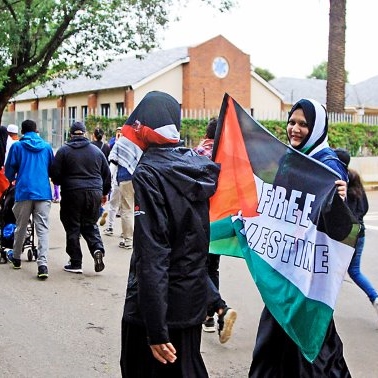
Featured Item

Raining on the first ‘walk for freedom’
OWN CORRESPONDENT
This was to be the very first time such a protest has been proposed and held in the heart of suburban Johannesburg. It started in Marks Park, Emmarentia and wound its way for five kilometres around the suburb.
There were slick advertising posters up for at least a week beforehand, calling for people to join in this “fun walk” for Palestinian freedom.
There was also a masterful social media campaign to entice people to join the protest to commemorate the 40th anniversary of the United Nations’ declaration of an International Day of Solidarity with Palestinian people.
On November 29, 1977, the UN General Assembly called for the annual observance of this day. On the same day in 1947, the General Assembly adopted the Partition Resolution that provided for the establishment of separate Jewish and Arab states, side by side.
“When are you going to make a difference for Palestine,” were the words in the highly emotive marketing video. “Show your support for the oppressed. How much pain and suffering can they take? Do you really feel their pain? As a South African, make a stand … Let us unite and show our support. Walk for Freedom … Be Seen.”
Wendy Kahn, national director of the South African Jewish Board of Deputies, says: “It is the right of any South African to protest and hold political opinions. Our understanding is that this event was peaceful and that there was no apparent hate speech.
“Unfortunately in the past these anti-Israel events have often degenerated into incidents of anti-Semitism,” she says.
However, beforehand, the community was not sure what to expect, in terms of how big it would be and how aggressive.
The CSO was on high alert around many of the areas where the Jewish and Muslim communities live side by side, not least of all the area of the scheduled walk.
Be it the rain or be it just a lack of interest, less than 400 people attended the rally and the “walk for freedom” was very peaceful. The route went directly past the Emmarentia Shul, which was closed for business that afternoon. As the protesters past the shul, some snide comments were passed and a few raised voices shouting pro-Palestinian slogans, but they were quickly quelled.
The CSO had warned a number of the shuls’ spiritual leaders – including Emmarentia and Greenside – that it would be advisable not to hold the Mincha and Maariv afternoon services at the usual late afternoon time. Instead, many shuls chose to have Mincha right after a brocha and/or shiur around midday.
“While we weren’t expecting any problems, we believed it was worth taking precautions to ensure that Jewish people were not walking to and from shul at the same time or just after the march,” said Jevon Greenblatt, CSO director of operations. “We can protect people at shuls, we can’t protect them out on the road.”
The CSO wasn’t worried that the organisers would incite violence, but that there might be fringe elements that could go out looking for trouble and target shuls or Jewish people on the roads.
“We will not be intimidated by this, but most religious leaders saw the validity of not taking chances,” says Greenblatt. He said it “was impossible to imagine how many people would venture to join, particularly because of the high level of marketing”.
As it happened, it was a rainy day and when the event began at 14:00, with pop-up stands at Marks Park and speeches, there were very few people. The numbers grew slowly during the speeches and by the time they left on the “freedom walk”, the crowd had swelled to around 400. The Johannesburg Metropolitan Police Department and the PSA’s own members monitored the walk.
Despite the numbers, this was seen as a very successful protest because as Ismail Moola, spokesperson for the Palestinian Solidarity Alliance, told Saalamedia, it was a challenge to have this walk outside of the “traditional Muslim apartheid areas” and bring it to “the north”.
Moola said: “We have been trying for many years to get some traction there (in the northern suburbs).” He added that coming to “the north” meant they had to be far more “creative and innovative”.
So, there may not have been thousands of people, but they significantly put their footprint in the northern suburbs, which could be the beginning of an annual trend.
Says Greenblatt: “The truth is this was a once-off event and plans were made to increase security. However, we have to ensure that every day and every Shabbos, we have sufficient measures in place to prevent any ugliness.
“It takes one lone wolf who is triggered by something said or done. So, as a community, we need to be building long term resilient and sustainable protection – not just for annual marches.”
Greenblatt explains that there is “no power in panicking”, the best defence is to always have the right security in place. Also, it is important for the community to keep CSO informed about anything they hear that might be an attempt to breach security, he says.





Adam Shapiro
November 30, 2017 at 10:24 am
‘Rained the entire day. Obviously, G-d is a Zionist!’
nat cheiman
December 5, 2017 at 5:33 pm
‘Lets see what happens when President Trump moves the US embassy to Jerusalem.
Maybe the traction that these people talk about will wilt.
‘